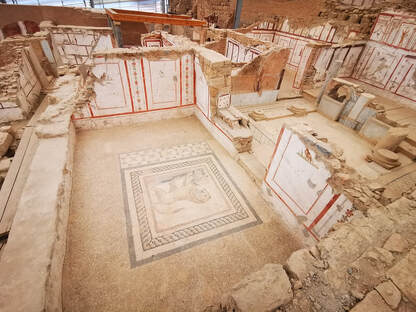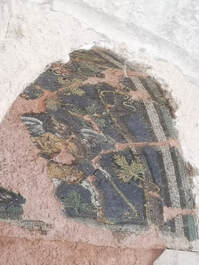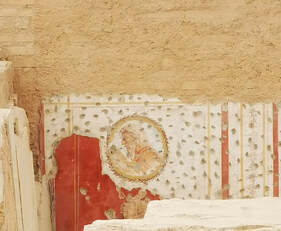 Terrace Houses at Ephesus, Turkey Terrace Houses at Ephesus, Turkey
So far we have mostly looked at structures that served public, official or administrative functions in Ancient Ephesus.
The Hillside or Terrace Houses on the other hand afford as a glimpse into a more private side of life in Ephesus which makes them perhaps the most riveting and poignant of Ephesus' many marvels.
 General View of a Roman House at Ephesus General View of a Roman House at Ephesus
Built in the hellenistic style, these houses consisted of a central courtyard surrounded by rooms and living quarters.
The interiors were ornate in nature in contrast to the rather simple exteriors. Most made use of Hypocaust to heat the floors and the walls.  A Religious Scene from a Ceiling Mosaic at Terrace Houses A Religious Scene from a Ceiling Mosaic at Terrace Houses
The discovery of shops and religious structures would suggest that these hillside residences were not only living spaces but were also used for religious and spiritual ceremonies and for production purposes, too.
The residences were in use from the 1st Century BC up to the 7th Century AD. A characteristic of these houses is the aesthetic awareness they display.  Dionysus, A Floor Mosaic from Terrace Houses Dionysus, A Floor Mosaic from Terrace Houses
The floors were decorated with mosaics, generally of a black and white and geometric design in keeping with the traditional mosaic style of the Roman Era.
However colored mosaics featuring scenes and figures from mythology were also used to beautify the dwellings. To Read More about Nereid & Triton Mosaic please click here.  A Fresco Wall Painting at Ephesus A Fresco Wall Painting at Ephesus
The walls were decorated with mythological scenes and characters and with theatrical masks as per the artistic tradition of the period.
Once you get into the interior of these wonderful homes, you can gain an insight of the artistic and aesthetic customs of the time and get to know everyday life in greater details.  Philosopher Cheilon, one of the Seven Sages of Greece Philosopher Cheilon, one of the Seven Sages of Greece
Hillside Terrace Houses were abandoned as a result of a series of huge earthquakes, but by the late antique period, urgent demands meant they were being re-utilized once more.
 An Atrium Courtyard & Marble Studio An Atrium Courtyard & Marble Studio
TModifications and renovations began to be made to the structures in the 5th Century AD.
And by the beginning of the 7th Century, during the Early Byzantine period, a handcrafts quarter to have been established with many of the houses, converted into Mills, Smithies or Forges. The evidence suggests that this section of the Second Hillside Residence was used as a small marble-cutting studio. |
